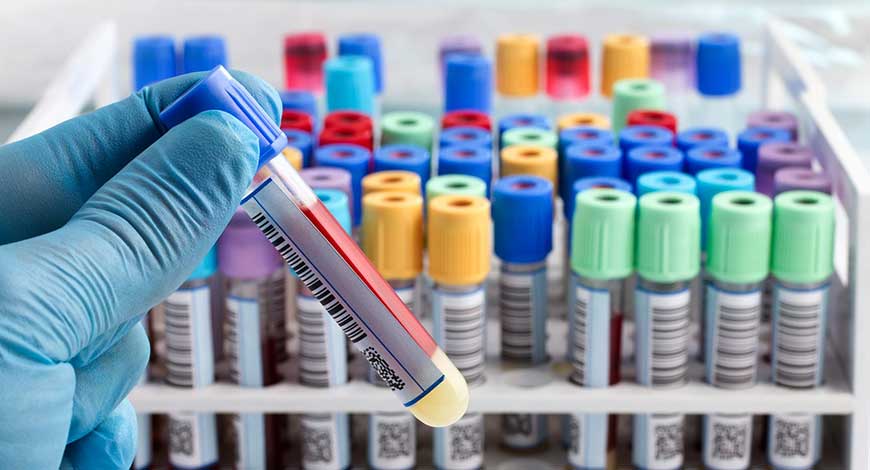Hematology Instruments and Reagents
Innovation to drive a new era of blood testing

With point-of-care testing on the rise, PoC hematology analyzers are expected to grow at a rapid pace compared to standalone devices in coming years.
Many analytes can be qualitatively detected or quantitatively measured using point-of-care testing (POCT); examples of commonly used POCT are tests for glucose, blood gases, cardiac markers, urinalysis, creatinine, prothrombin time/international normalized ratio (INR), infectious diseases (human immunodeficiency virus [HIV], respiratory syncytial virus, influenza, etc.), and drug screening. The considerable success of POCT is attributed to increasing clinical demand, heavy industry promotion, short turnaround time, economical and practical factors, and advancements in technology, such as lab-on-a-chip systems that use miniaturization, micromachining, microfluidics, nanotechnology, and wireless communication.
In hematology, POCT is generally limited to hemoglobin and hematocrit testing by blood gas devices and point-of-care coagulation monitoring, such as prothrombin time and INR for patients on warfarin.
Some studies have investigated portable instruments, using newer technology, such as single-sample cuvettes and image analysis, microfluidic cartridges, and the lab-on-a-chip/micro total analysis system platform, which provides complete blood cell count tests including 3-part differential white blood cells, red blood cells, platelet count, and hemoglobin for rapid diagnosis in resource-poor environments. A rapid complete blood cell count and differential blood panel can help clinicians determine whether a patient is suffering from a viral or bacterial infection and whether he or she requires admission and antibiotics.
The use of POC INR testing has become popular for at-home testing and allows patients to easily use a device to monitor their INR and report their results to a clinician (either in person or via telephone), who can then adjust anticoagulant dose, if necessary. The most common symptom of patients with venous thromboembolism is chest pain or dyspnea, but patients may also present with leg problems, arm pain, or chest tightness, or be asymptomatic. In a systematic review and meta-analysis of 11 trials with data for 6417 participants and 12,800 person-years of follow-up, there was a significant reduction in thromboembolic events in the self-monitoring INR group (hazard ratio, 0.51; 95 percent CI, 0.31–0.85) on oral anticoagulation. Eight participants younger than 55 years showed a striking reduction in thrombotic events (hazard ratio, 0.33; 95 percent CI, 0.17–0.66), as did participants with mechanical heart valves (hazard ratio, 0.52; 95 percent CI, 0.35–0.77), so the authors suggested that patients should be offered the option to self-manage their disease with suitable healthcare support.
In one investigation, negative D-dimer test was valuable in ruling out acute pulmonary embolism in patients, with a low pretest probability in hospital outpatient or accident and emergency settings. Combined with pretest probability scores, POC D-dimer tests are a quick and safe way to rule out venous thromboembolism and improve patient experience. In addition, the D-dimer POC device was comparable with the laboratory device, and was sufficiently accurate for use as a screening tool in the emergency department (ED) setting. In a prospective observational study of 104 patients who underwent simultaneous D-dimer measurements using the two analyzers, the median time for D-dimer results from triage by VIDAS was 258 minutes (interquartile range, 173–360 minutes) and that by AQT90 analyzer was 146 minutes (interquartile range, 55–280.5 minutes). Following implementation of the rapid whole-blood D-dimer test in the ED, there was a 13.8-percent decrease in patients admitted to the hospital, a 7.3-percent increase in patients discharged from the ED, and a 6.4-percent increase in patients admitted for observation only. General practitioners can safely exclude pulmonary embolism by using the Wells criteria in combination with either a qualitative POC D-dimer or a quantitative D-dimer test.
The global hematology analyzer market size was valued at USD 1984 million in 2021, and is projected to reach USD 3941.10 million by 2030, registering a CAGR of 7.30 percent from 2021 to 2030. Reagent and consumables segment dominated the global market in 2021, and is expected to remain dominant throughout the period 2021–2023 owing to factors such as increase in adoption of reagent and consumables in clinical laboratories for blood cell counts, coagulation testing, other hematology tests, control, and calibration.
Based on type, fully-automated hematology analyzer segment dominated the global market in 2021, and is anticipated to continue this trend over the next 9 years. 5-part hematology analyzers are expected to be the most prominently used type of analyzers across the world, holding over ¾ of the market share in 2021.
With POC testing on the rise, POC hematology analyzers are expected to grow at a rapid pace compared to standalone devices during 2021–2023.
Companies largely gain their competitive advantage and economic benefits from innovation. Innovation is advantageous and helps in acquiring new markets, generates revenues, and creates customer value propositions. Innovation contributes to higher productivity, lower costs, increased profits, and improves existing product lines and processes. Firms that innovate have a higher global market share, higher penetration rates, and higher profitability. Innovative products also attract more customers. The hematology analyzers market has also seen a similar trend since the past decade.
Abbott, PixCell Medical, Drucker Diagnostics, PTS Diagnostics, Sysmex Corporation, Sight Diagnostics, BioSystems S.A., Diatron, HORIBA Medical, Norma Instruments Zrt, Hemocue, Westgard, EKF Diagnostics, Sterilab Services, and Radiometer Medical ApS, among others, are some of the key players in the market.
The availability and use of POC blood testing has increased in recent decades – what are some of the advantages and limitations of POC blood testing compared with lab analysis?
The use of POC testing brings the results closer to the patient and reduces turnaround time; however, there are considerations that should be weighed up when deciding to implement POC testing.
Biomedical staff within the laboratory are skilled in the operation and maintenance of analyzers and the interpretation of results. POC instruments are normally operated by other healthcare professionals whose primary focus is not the analyzer.
Modern POC analyzers are designed to be easy to use with clear assistance for the operator and offer comparable results; however, if the turnaround time from the laboratory does not impede patient care, then a laboratory-processed test will always be preferable.
Reagents constitute a critical part of the hematology system
 Helena Börjesson
Helena Börjesson
Chief Technology Officer Research and Development,
Boule Diagnostics AB
An automated hematology system includes the analyzer and its dedicated consumables, which are designed concomitantly to provide optimized performance and enhanced serviceability of the complete system.
Reagents and analyzer measurement technology, including the analysis algorithms, are fine-tuned to each other to produce the most accurate patient results. Formulations, dilutions, mixing, and reaction kinetics are all carefully matched and optimized to work together.
The dilution reagent shall provide an isotonic environment for the cells, and the sample dilution ratio is critical for an accurate cell count. The lytic reaction shall be harsh enough to hemolyze the red blood cells to release hemoglobin for determination of its concentration, yet sufficiently gentle to shrink the white blood cells in a controlled manner to allow accurate differentiation of these cells into their subgroups. The diluent and lyse reagents work together to control the lytic reaction for an optimized differentiation of the white blood cells and an accurate quantification of hemoglobin.
The consumable formulations also need to be compatible with the analyzer materials to prevent damage of the components, and cleaners are designed to keep the system working at peak performance and to reduce the need for additional maintenance or service calls.
Since the very first automated hematology analyzers were introduced in the 50s, manufacturers have put much effort into testing and optimizing the cell-count process. The test results provide operators with knowledge of system performance to support in clinical decision-making. Knowledge, not only of system performance but also of its limitations, is especially important in extreme conditions, as automated hematology systems are used in health screenings to identify pathological samples that might need further investigation.
For operator convenience, reagents are entered by simply scanning an RFID card on the reagent container and the analyzer stores key information, such as reagent lot number, open and expiry dates, and the remaining volume. At the same time, the reagent lock helps ensuring proper use of the analyzer by only allowing the use of consumables that are specifically designed for the intended analyzer, for optimized analytical quality and performance of the automated hematology system.
That said, there are many instances where very rapid access to results can make a tangible difference to patient care and diagnosis.
The Microsemi CRP LC-767G, for instance, combines the FBC with a C-reactive protein level (CRP), which is a marker for acute inflammation and infection. This suite of results helps the clinician quickly assess the patient and make decisions about the next steps, such as whether to admit or whether to prescribe antibiotics. This is an important weapon in the fight against anti-microbial resistance. If deployed in the community, POC testing can help to avoid costly and unnecessary admissions to hospital, which is a benefit to the patient, particularly with children and the elderly, and can also save valuable hospital resources.
Other POC FBC instrumentation may be used to assess patient medication. By placing an analyzer in a chemotherapy unit, cancer patients can have blood taken to determine if it is safe for them to receive their treatment. As the results are available immediately, these vulnerable patients do not have to spend any longer than necessary in a hospital or clinic and can avoid additional visits. This has been invaluable during the pandemic to keep chemotherapy patients away from areas where there was a high-risk of exposure to Covid-19.
A similar solution, where an instrument is deployed in mental health clinics and used to manage the prescription of the anti-psychotic drug, clozapine. Access to POC FBC testing means that patients can be treated in the community. The ability to test and prescribe in a single visit helps patient compliance with the medication.
Thus, with well established procedures, the right equipment and excellent operator training, a POC solution has the capacity to transform the patient pathway.
Point-of-care testing is likely to play an increasing role in healthcare delivery in the future. It will improve access to healthcare and increase the efficacy of service provided to patients. Although POCT provides laboratory results faster than the traditional central laboratory, process improvement is needed to optimize the accuracy of laboratory results.
Molecular POCT for common pathogens in select populations, such as in intensive care or other common illness presentations, needs to be evaluated to further improve patient care and effectively manage healthcare resources. Despite several advantages of POCT, limitations include cost, imprecision and inaccuracy, requirement for an interdisciplinary approach, and human error. Although the use of POCT is expanding in many areas, the limitations must be understood and improvements in analytical performance achieved to properly interpret POCT results.












